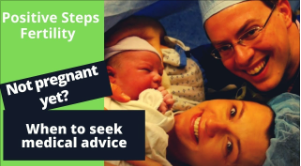If you’re trying to conceive, you may be wondering what works—and what’s just noise. I hear it every day: “How can I get pregnant faster?” There’s a lot of information out there, and some of it can feel overwhelming. So let’s break it down.
I want to share some of the most common questions I get, backed by both science and experience. My goal is to help you focus on what truly matters, so you can move forward with confidence—and hopefully, faster success.
Let’s Start with the Basics: How Do You Get Pregnant?
It seems like a simple question, right? After all, humans have been doing this for millennia. But when people start trying to conceive, they often overcomplicate the process. So let me walk you through what has to happen for a pregnancy to begin.
At its most basic, you need sperm, you need an egg, and they need to meet at the right place and time. That meeting happens in the fallopian tube. Then, if all goes well, the fertilized egg (now an embryo) needs to travel to the uterus and implant.
Now, here’s where people often get confused. Some women think they ovulate when they have an orgasm. Nope. That’s not how it works for humans. In order for ovulation to happen, the egg has to grow to a certain size—if it’s not big enough, it’s simply not ready to be released.
That’s why ovulation usually happens around day 14 of a 28-day cycle, though it can vary. When the egg is mature enough, it’s released from the ovary and travels into the fallopian tube, where it can be fertilized if sperm are already present. If that part goes well, the embryo begins migrating back toward the uterus, a journey that starts around day 17. By about day 19, implantation typically occurs, meaning that’s when the embryo attaches to the uterine lining.
So the timing isn’t just about ovulation—it’s about everything lining up: healthy sperm, a mature egg, open fallopian tubes, and a receptive uterus. If any one of those steps is out of sync, it can make getting pregnant more difficult.
The good news? You don’t need to micromanage every part of this on your own. But understanding the process can help you focus on what matters most—and know when it might be time to get help.
Medically speaking
- Ovulation: Occurs roughly mid-cycle; the LH surge precedes ovulation by ~24–36 hours. ASRM notes this as a normal part of the menstrual cycle.
- Fertilization: Happens in the fallopian tube, not the uterus.
- Implantation: Typically occurs about 6–10 days after ovulation, often placing it around day 19–21 in a 28-day cycle. This matches Dr. Parry’s statement about implantation on day 19 post-cycle start.
- No orgasm-ovulation link: Correct—human ovulation is not orgasm-triggered (unlike reflex ovulators like rabbits). This is basic reproductive biology.
When Should You Have Sex to Get Pregnant? Your Fertile Window
This is probably the most common question I get: How do I time things right? And I get it—when you’re trying to conceive, every day can feel like it counts. I’ve seen couples turn their bedroom into a fertility fire drill the minute the ovulation predictor kit turns positive: “Go, go, go!”
But it doesn’t work like that.
What we’re talking about here is your fertile window—the handful of days each cycle when pregnancy is most likely to happen. That window usually includes the five days leading up to ovulation, plus the day you ovulate. Why? Because sperm can survive for up to 72 hours, and the egg is only viable for about 12–24 hours after ovulation. So conception happens when sperm are already present and waiting when the egg is released.
Thankfully, we don’t need perfect timing to make that happen. If it required hitting a split-second window, we’d have died out as a species long ago.
To keep things simple, I often tell couples to have sex every two to three days during the middle of their cycle. For example, Wednesdays and Saturdays are easy to remember and give you consistent coverage. If you prefer a calendar-based approach, try days 11, 14, and 17, with day 1 being the first day of full menstrual flow. This works well for people with regular cycles.
You don’t need to overthink it. But here’s the thing—if you’re doing this consistently and nothing’s happening after several months, it might be time to take a closer look.
Statistically, about 75% of women will be pregnant within three months of trying. If it’s been six, nine, or twelve months and nothing’s happened, you should’ve had a few good chances already. That’s when we start asking: Is something else going on?
That doesn’t automatically mean something’s wrong. But it does mean it’s worth evaluating. The sooner we understand what’s happening, the sooner we can help you find the right path forward.
How Often Should You Have Sex to Improve Your Chances of Conceiving?
I’ve had couples walk into my office looking sore and exhausted—both of them practically limping—because they’ve been having sex every single day, sometimes twice a day, thinking it’ll increase their chances of getting pregnant. I appreciate the commitment, but the truth is: more isn’t necessarily better.
There was a study published in The New England Journal of Medicine back in 1995 by a guy named Wilcox. He looked at how often couples had sex leading up to ovulation and whether the frequency changed the outcome. What he found was pretty eye-opening: once you’re within the fertile window, having sex two, three, four, or even five times leading up to ovulation didn’t make a difference in the pregnancy rate. Zero times? Obviously, that makes it tough—unless we’re talking divine intervention every 2,000 years.
So here’s what I tell my patients: have sex every 72 hours around ovulation. Two or three well-timed encounters during that window should be enough to cover you.
When That Advice Doesn’t Apply
Now, this assumes the sperm are healthy and live a typical lifespan—around 72 hours. But in some cases, sperm may not survive that long, and that changes the game.
If there’s a known male factor—say a history of cryotherapy, Chlamydia cervicitis, or anything that’s affected the cervix or semen quality—then sperm may have a much shorter window of viability. In those cases, more frequent attempts might be needed, or it may be time to look into further evaluation.
And, of course, if there are mechanical issues—like if your tubes are tied, or if you’ve had pelvic inflammatory disease, ruptured appendicitis, or advanced endometriosis—then how often you have sex won’t matter if the sperm and egg can’t meet.
That’s why I always say: if you’ve been trying and it’s not working, don’t keep guessing. Get evaluated. Know if your tubes are open, if sperm are functioning properly, and if your uterus is ready for implantation. Because when something’s off, no amount of enthusiastic bedroom effort can overcome a physical barrier.
And if everything checks out? Then yes—a few well-timed, low-stress encounters around ovulation are often all you need.
Does Sex and Orgasm Help with Fertility?
Now, for the guy, it obviously matters—if sperm isn’t released into the reproductive tract, pregnancy just isn’t happening. But when people ask if orgasm helps fertility from the woman’s side, I have to gently break it to them: humans don’t ovulate from orgasm.
Some species do—rabbits are a classic example. When they have sex, it actually triggers ovulation, and they release all their eggs at once. But in humans, that’s not how it works. Orgasm doesn’t make the egg release, and it doesn’t increase the odds of conception.
That said, it’s still worth making sure everyone’s cared for in the process. Trying to conceive can be stressful, and if sex becomes clinical or pressured, it can take a toll on your relationship. Having fun, staying connected, and not letting this turn into a chore actually can help—because anything that reduces stress and keeps you emotionally healthy supports your overall well-being during this journey.
So no, orgasm doesn’t directly impact fertility for women. But enjoying the experience and keeping intimacy positive? That absolutely matters.
Does Position Matter When Trying to Get Pregnant?
I hear this one a lot—people asking if they need to be at a certain angle or use specific positions, especially if they’ve been told they have a tilted or retroflexed uterus. Let me clear that up: it’s just not true.
Sperm are remarkably efficient. After ejaculation, they reach the uterus in about two minutes, the fallopian tubes within five minutes, and hit peak concentration by around ten minutes. So whether they get there in a minute and 50 seconds or two minutes flat doesn’t make any difference—especially when they can live up to 72 hours.
We actually talked about this in a previous blog: Can Sexual Position Impact Your Ability to Get Pregnant? The idea is that certain positions—like missionary or doggy style—might “help” by placing sperm closer to the cervix. But there’s no scientific evidence supporting that. Once sperm are released, it’s their mobility—not the position you were in—that matters most.
What does matter is timing intercourse around ovulation and making sure your reproductive health is in good shape. If those things are in place, you don’t need to worry about finding the “perfect position.” Choose what’s comfortable and keeps the experience positive for both of you.
How Valuable Is an Ovulation Predictor Kit?
People often ask me, “Do I need to precisely know when I’m ovulating?” And honestly, no—you really don’t.
Ovulation predictor kits (OPKs) can be helpful, but they’re not essential. What they’re measuring is your LH surge—a signal that ovulation is approaching. Some of the fancier kits get more specific, and if getting pregnant truly required that level of precision, we probably wouldn’t exist as a species today.
The truth is, sperm usually live around 72 hours, so if you had sex a day or two before ovulation, there’s a good chance you’ve already covered your fertile window. Unless there’s a reason sperm wouldn’t survive that long—like poor semen quality or issues with the cervix—you really don’t have to time things perfectly.
That said, some people like the idea of managing details and feeling more in control, and there’s nothing wrong with that. If using OPKs gives you peace of mind, great. But if you’ve been using them consistently without success, it may be time to ask whether something else is going on, because timing is rarely the main reason for fertility struggles.
Does using Lubricants With Sex help you get pregnant?
This is one of the more common myths I hear—people think lubricants help sperm “get where they need to go.” The idea makes intuitive sense: if things are more slippery, maybe sperm can swim better, right? But in reality, that’s not how it plays out.
In fact, most over-the-counter lubricants are spermicidal or sperm-toxic. They either kill sperm or slow them down so much that they can’t reach the egg. I’ve seen patients with perfectly healthy sperm counts watch those numbers crash in real-time when exposed to the wrong lube. So if you’re using lubricants and trying to conceive, it’s important to get this part right.
Many couples experience vaginal dryness during the process of trying to conceive—it’s more common than people think. And that dryness can make intimacy more difficult. So the instinct to reach for a lubricant is understandable. But what you use matters a lot.
Lubricants typically fall into one of four categories:
- Oil-based (like coconut oil, baby oil, massage oil): Long-lasting but can degrade condoms and may irritate vaginal tissue.
- Water-based: Easier to wash off and often condom-safe, but can dry out faster.
- Silicone-based: Longer-lasting and generally condom-safe, but not compatible with silicone sex toys.
- Hybrid lubes: Mix of types, but you still need to check ingredients carefully.
If you’re trying to get pregnant, you should avoid lubricants that contain ingredients like glycerin, sugars, parabens, petroleum jelly, propylene glycol, and anything antibacterial or numbing (like benzocaine). These ingredients can irritate vaginal tissue or harm sperm motility.
So, what lubricants are safe for fertility?
Look for sperm-friendly lubricants that have been tested and shown to be non-toxic to sperm. Products like Pre-Seed and Conceive Plus are two commonly recommended options in fertility clinics. They’re specifically formulated to mimic cervical fluid and support sperm survival.
I’ve also had patients ask about natural oils like olive oil or canola oil. Some small studies show they don’t seem to harm sperm, and pregnancy rates were similar to sperm-safe commercial lubricants. But here’s the concern: natural oils can increase the risk of infection or irritation for some people. So I’m cautious about recommending them broadly.
If you’re trying to conceive and need lubrication, make sure it’s something designed for fertility. If you’re not sure which product is right for you, talk with your provider. A little guidance here can make a big difference—and help keep the path to pregnancy as smooth as possible, in more ways than one.
How Do You Detect Ovulation?
This is an important question—and one that often gets more complicated than it needs to be.
Some women experience what’s called Mittelschmerz, which is a German word that literally means “middle pain.” Of course, the Germans have a word for everything—and as usual, it’s a mouthful.
It’s a twinge or cramp on one side of the lower belly that shows up once a month, usually around ovulation. A lot of people assume that this pain means the egg has just been released, but that’s not quite right.
What you’re feeling is actually the expansion of the follicle, not the moment the egg is released. The fluid around the egg doesn’t contain battery acid—it’s just growing and stretching the ovarian wall a bit. Now, there are a few common tools for detecting ovulation. Ovulation predictor kits (OPKs) measure the LH surge that precedes ovulation. Basal body temperature (BBT) charting looks for a slight rise in temperature that occurs after ovulation has already happened. But here’s the catch—BBT is retrospective. By the time you see the temperature shift, ovulation occurred about three days ago. At that point, the embryo (if fertilization occurred) is already making its way back through the fallopian tube toward the uterus.
And by the way, fertilization doesn’t happen in the uterus. It happens in the fallopian tube. That’s where sperm meet egg. The embryo starts migrating back to the uterus around day three, and implantation happens around days five to six after ovulation.
All that said, most people don’t need to track ovulation that closely. If sperm live for 72 hours and you’re having sex every two to three days around the middle of your cycle—say Wednesdays and Saturdays—you’re likely covering your fertile window just fine.
Charting cycles or checking temperatures every morning might feel like you’re “doing something,” but it can also be emotionally exhausting. I’ve had many patients tell me it turns into a daily reminder that they’re still not pregnant. If your cycles are regular, you probably already know that. And if they’re irregular, or if you suspect you’re not ovulating at all, that’s a good time to talk with a fertility specialist.
But for most people, timing sex consistently around mid-cycle is enough. Don’t let the data tracking distract you from the bigger picture—or wear you out emotionally.
Is It Okay to Pee After Sex if You’re Trying to Get Pregnant?
Yes, it’s absolutely okay to pee after sex—and no, you’re not going to pee out the sperm.
Sperm reach the uterus quickly, usually within minutes after ejaculation, and the urinary system and reproductive system are completely separate. The bladder and the uterus don’t connect, so urinating doesn’t wash anything important away.
That said, some people are more prone to urinary tract infections (UTIs), and in those cases, peeing before and after intercourse can help reduce the risk of infection. This becomes especially important if you’re using lubricants, since some can increase irritation or bacterial imbalance.
If you’re someone who gets UTIs frequently, talk with your doctor about strategies that work best for your body. But from a fertility standpoint, urinating after sex won’t hurt your chances of getting pregnant, and for some, it may actually help prevent problems down the road.
Don’t Suffer in Silence: Get Answers, Find Peace
At Positive Steps Fertility, we’re here to provide clarity and support as you navigate this journey. If you’re feeling frustrated or unsure about your next steps, let us help.
Together, we can identify what’s truly impacting your ability to conceive and develop a plan to address it. You don’t have to go through this alone. Reach out today and take the next positive step forward.




